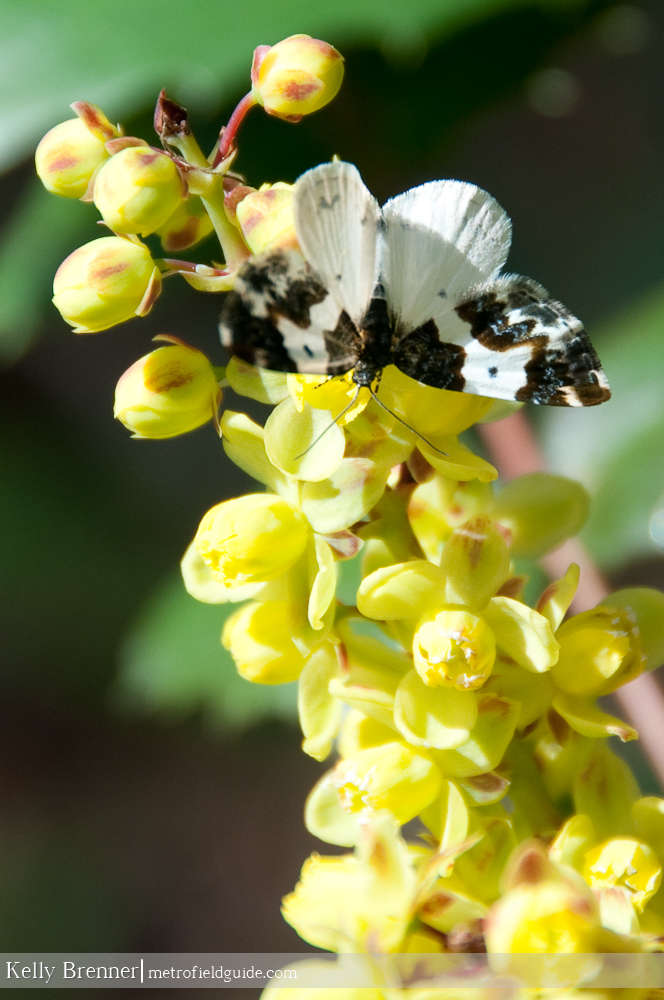
Spring Moth
Moth species outnumber butterflies in North America 14-1 and they have so many species that in the animal world, only beetles have more. There are over 142,000 species world-wide, more than ten-thousand in North America and in the Pacific Northwest there are as many as ten times as many moth species as butterfly species. They have more varied patterns and like butterflies, act as important pollinators. Their caterpillars also provide important food for songbirds, particularly breeding birds and young as well as bats and even spiders.
So why are there countless resources for designing butterfly habitat, but only a handful for moths? Unfortunately, moths get a bad rap as a pest and they’re more likely to be found in the pest section of extension service’s websites while butterflies are on the attracting wildlife sections. The truth is that less than one-tenth of one percent of moth species are the type that invade closets. Another reason they’re overlooked is because moths are active at twilight and during the night and there are fewer people around to impress during that time. One additional reason they’re not addressed much in design guides is that they have much the same requirements as butterflies, but they are different enough to warrant a chapter in many books.
While many moths frequent the same flowers that butterflies do, such as Milkweed, Garden Phlox and Flowering Tobacco, there are many night-blooming flowers that are available for moths such as Jasmine, Fireweed, Lilac, Yucca and Bee balm. There is a very complex relationship between moths and plants. It’s not yet fully understood how moths choose flowers and whether it’s based on fragrance, form or the color. Many of these plants have strong perfumes and/or are white and many are open at night. While the moths feed they inadvertently pick up pollen and thus serve as affective pollinators. In fact the yucca moths are the sole pollinators of the yucca which also serves as the host plant for the larvae of the yucca moth.
Like butterflies, pesticides are not conducive to moth habitat but an additional threat is the “bug zapper” which has little impact on the targeted pests such as mosquitoes, but a negative impact on other night fliers such as moths.
The best way to create habitat for moths is to first find out which species inhabit your region. You can figure that out by doing a map search at the Butterflies and Moths of North America website. Once you have a list, study each of the species to find out what their habitat is, what their adult nectar plants are and what the larval host plant is. For example, I looked up King County in Washington and found the Snowberry clearwing. The website says their habitat is wide ranging including streamsides, gardens, suburbs and fields. Their larval host plant is, not surprisingly, the snowberry, honeysuckle and dogbane. The adult nectar plants include snowberry, lilac, thistles and orange hawkweed. If you can’t find information on this website, try a web search for your species to find out if their hosts plants are known. Finding plants for moths is not as easy as finding plants for butterflies, but the Pollinator Friendly Planting Guides from the Pollinator Partnership includes moths in the regional plant lists.
Once you have some target species that are likely to frequent your landscape and a plant list, then start considering other design elements which are similar to the needs of butterflies including a sheltered area from the wind, clustering of the same plants, weedy areas and basking sites. See Design for Butterflies for more information about butterfly design.
What are some differences between moths and butterflies? For the most part, moths fly at night while butterflies are out during the day. Most moths are less brightly colored than butterflies, but there are exceptions. The antennae of a butterfly will have a knob at the end while the antennae of a moth lacks the knob or has large, feather-like antennae.
More from The Metropolitan Field Guide::
Book Review:: Discovering Moths: Nighttime Jewels in Your Own Backyard
Book Review:: an obsession with butterflies, our long love affair with a singular insect
Further Reading::
Butterfly Gardening: Creating Summer Magic in Your Garden (Book)
Landscaping for Wildlife in the Pacific Northwest (Book)
Moths:: Arizona Sonora Desert
Beneficials in the Garden, The Pollinators: Moths:: Galveston County Master Gardeners
Attracting Moths to Your Backyard:: University of Colorado Museum of Natural History
Butterflies and Moths of North America
Pollinator Friendly Planting Guides:: Pollinator Partnership






4 Comments